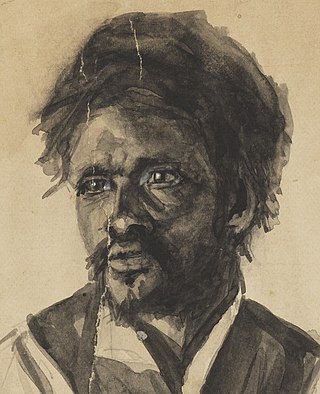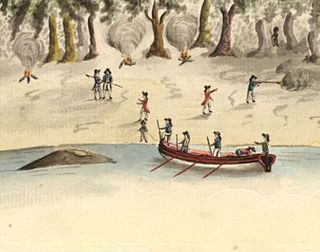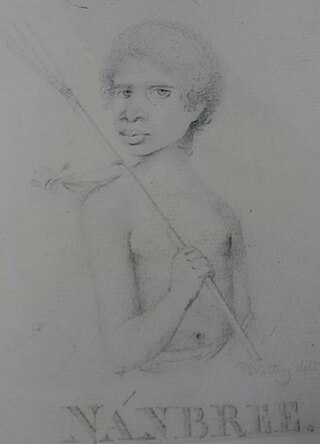
Woollarawarre Bennelong, also spelt Baneelon, was a senior man of the Eora, an Aboriginal Australian people of the Port Jackson area, at the time of the first British settlement in Australia in 1788. Bennelong served as an interlocutor between the Eora and the British, both in the colony of New South Wales and in the United Kingdom.

The Dharug or Darug people, are an Aboriginal Australian people, who share strong ties of kinship and, in pre-colonial times, lived as skilled hunters in family groups or clans, scattered throughout much of what is modern-day Sydney.

The Eora are an Aboriginal Australian people of New South Wales. Eora is the name given by the earliest European settlers to a group of Aboriginal people belonging to the clans along the coastal area of what is now known as the Sydney basin, in New South Wales, Australia. The Eora share a language with the Darug people, whose traditional lands lie further inland, to the west of the Eora.

Pemulwuy, was a Bidjigal warrior of the Dharug nation, born around 1750 in the area of Botany Bay in New South Wales, Australia. One of the most famous Aboriginal resistance fighters in the colonial era, he is noted for his resistance to European colonisation which began with the arrival of the First Fleet in January 1788.

Baulkham Hills is a suburb in the Hills District of Greater Sydney, in the state of New South Wales, Australia. It is located within 30 kilometres north-west of the Sydney central business district mostly within the local government area of The Hills Shire, of which Baulkham Hills was formerly the administrative seat and namesake of The Hills Shire. A small section of the suburb which is located south of the Hills Motorway-Windsor Road intersection is part of the City of Parramatta.

Prospect is a suburb of Sydney, in the state of New South Wales, Australia. Prospect is located 32 kilometres west of the Sydney central business district in the local government area of the City of Blacktown and a small part of Cumberland City Council, is part of the Greater Western Sydney region. One of the oldest suburbs in Sydney, Prospect takes its name from the prominent nearby landmark of Prospect Hill - from the top of which people could get a prospect of the surrounding countryside.
John Caesar, nicknamed "Black Caesar", was the first Australian bushranger and one of the first people of African descent to arrive in Australia.

Musquito was an Indigenous Australian resistance leader, convict hunter and outlaw based firstly in the Sydney region of the British colony of New South Wales and later in Van Diemen's Land.

Windradyne was an Aboriginal warrior and resistance leader of the Wiradjuri nation, in what is now central-western New South Wales, Australia; he was also known to the British settlers as Saturday. Windradyne led his people in the Bathurst War, a frontier war between his clan and British settlers.

The Bidjigal people are an Aboriginal Australian people whose traditional lands are modern-day western, north-western, south-eastern, and southern Sydney, in New South Wales, Australia. The land includes the Bidjigal Reserve, Salt Pan Creek and the Georges River. They are part of the Dharug language group, and there is debate as to whether the clan is part of the Dharug or Eora people.

The Australian frontier wars were the violent conflicts between Indigenous Australians and primarily British settlers during the colonial period of Australia.

Prospect Hill, or Marrong Reserve, is a heritage-listed hill in Pemulwuy and Prospect in the greater western region of Sydney, New South Wales, Australia. Situated about 30 kilometres west of central Sydney, the hill is Sydney's largest body of igneous rock and is higher than the ridges of the Cumberland Plain around it, with its present-day highest point being 117 metres high, although before its summit was quarried away it rose to a height of 131 metres above sea level.
The Battle of Richmond Hill, also known as the Battle of the Hawkesbury and the Richmond Hill Massacre, was a battle of the Hawkesbury and Nepean Wars, which were fought between the Indigenous Darug people and the New South Wales Corps.

The Hawkesbury and Nepean Wars (1794–1816) were a series of conflicts where British forces, including armed settlers and detachments of the British Army in Australia, fought against Indigenous clans inhabiting the Hawkesbury River region and the surrounding areas to the west of Sydney. The wars began in 1794, when the British started to construct farms along the river, some of which were established by soldiers.
Tedbury, also known as Tidbury and Tjedboro, was a Darug Aboriginal Australian involved in frequent acts of resistance to British colonists in the early years of New South Wales. He was the son of noted warrior and rebel Pemulwuy.
The Toongabbie Government Farm Archaeological Site is the heritage-listed site of a former convict government farm at Goliath Avenue, Winston Hills, City of Parramatta, New South Wales, Australia. The farm was built by convict labour from 1791 to 1813. Its site includes areas today known as Palestine Park, Oakes Reserve and Settlers Walk and is also known as the Toongabbie Government Farm Convict Site. It was added to the New South Wales State Heritage Register on 11 December 2012.

From the late 1700s until the end of the 19th century, the British Empire established, expanded and maintained a number of colonies on the continent of Australia. These colonies included New South Wales, Van Diemen's Land, Western Australia, South Australia, Victoria and Queensland. Many of these were initially formed as penal settlements, and all were built on land occupied by Indigenous Australians. In order to keep the large number of transported convicts under control, enforce colonial law and fight the Australian frontier wars, British military elements, including the British Army, were deployed and garrisoned in Australia. From 1790 to 1870 over 30 different regiments of the British Army consisting of a combined total of around 20,000 soldiers were based in the Australian British colonies.

Gringerry Kibba Colebee also spelt Colebe, Coleby or Colbee, was an eighteenth-century Gadigal man, an Aboriginal Australian people from present-day Sydney, New South Wales.

Nanbaree, also named Nanbarry and Andrew Snape Hamond Douglass White, was an Aboriginal Australian of the Gadigal clan who undertook a prominent role in establishing communication between the Aboriginal people and the colonists during the early stages of British occupation of the Sydney area. While still a child, he was the first Aboriginal Australian to acquire a functional level of English and became an important interpreter as he had very close kinship ties with prominent figures such as Bennelong and Colebe. During adulthood, he became a notable sailor, voyaging with Matthew Flinders.












